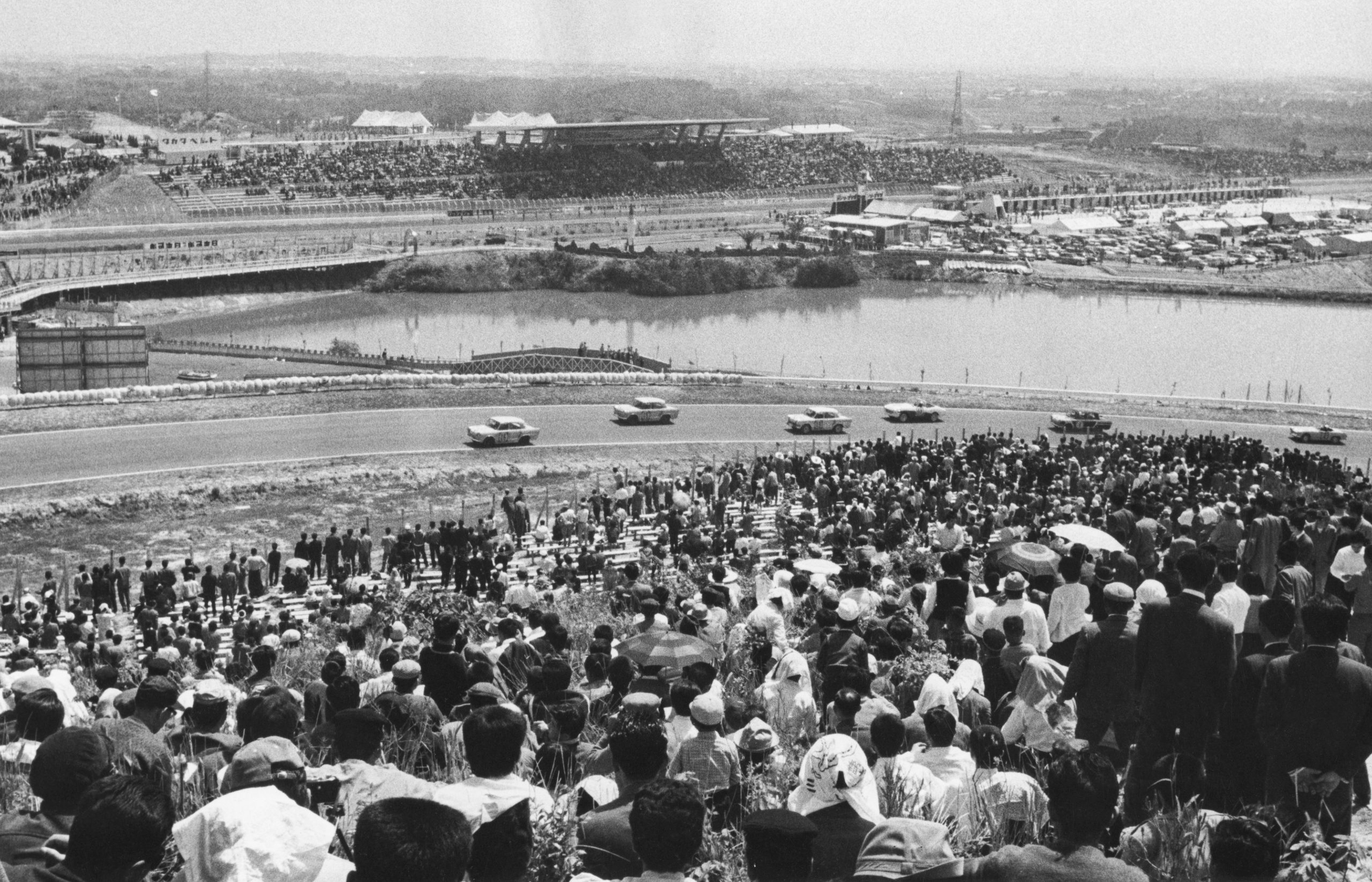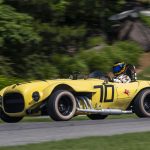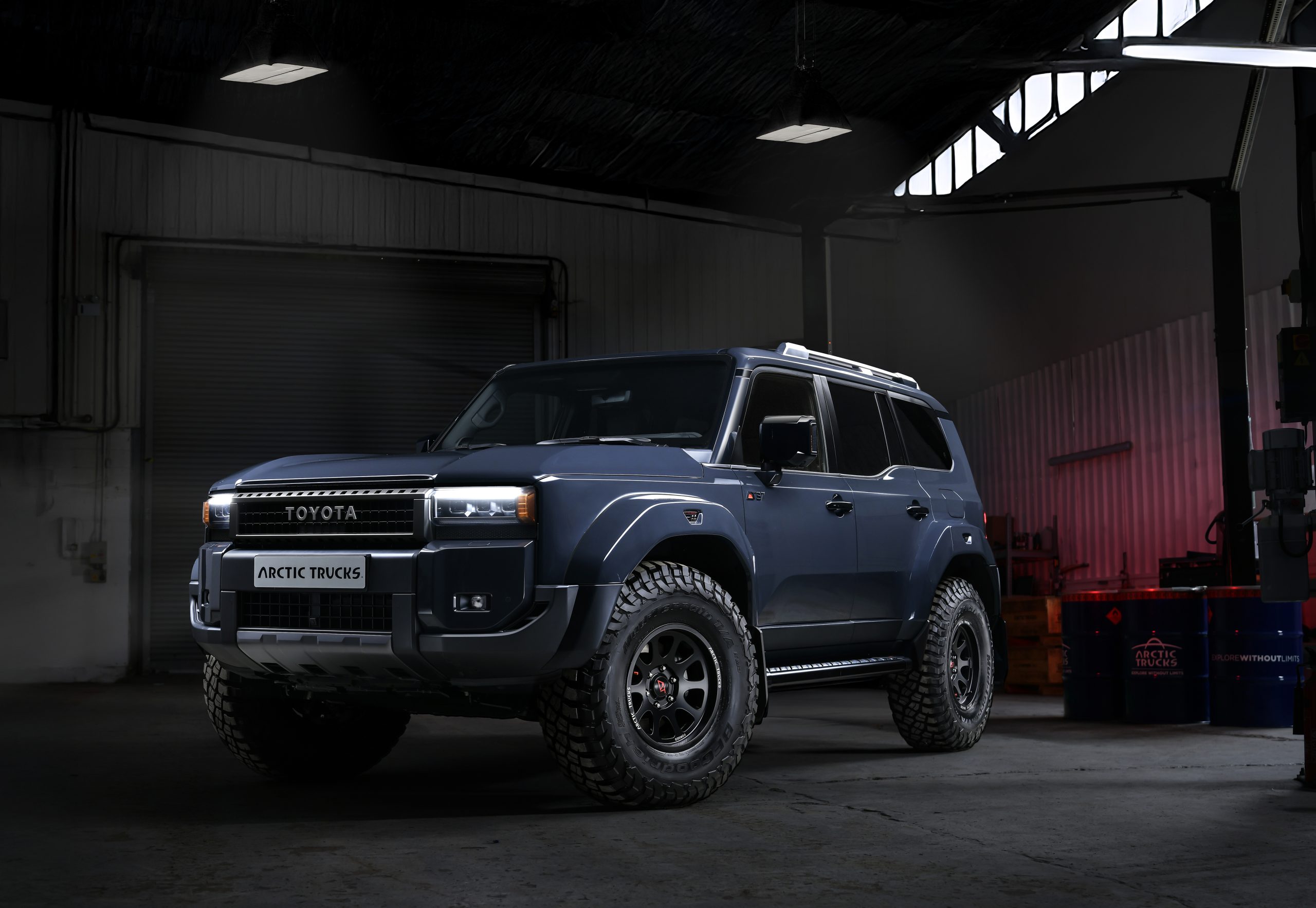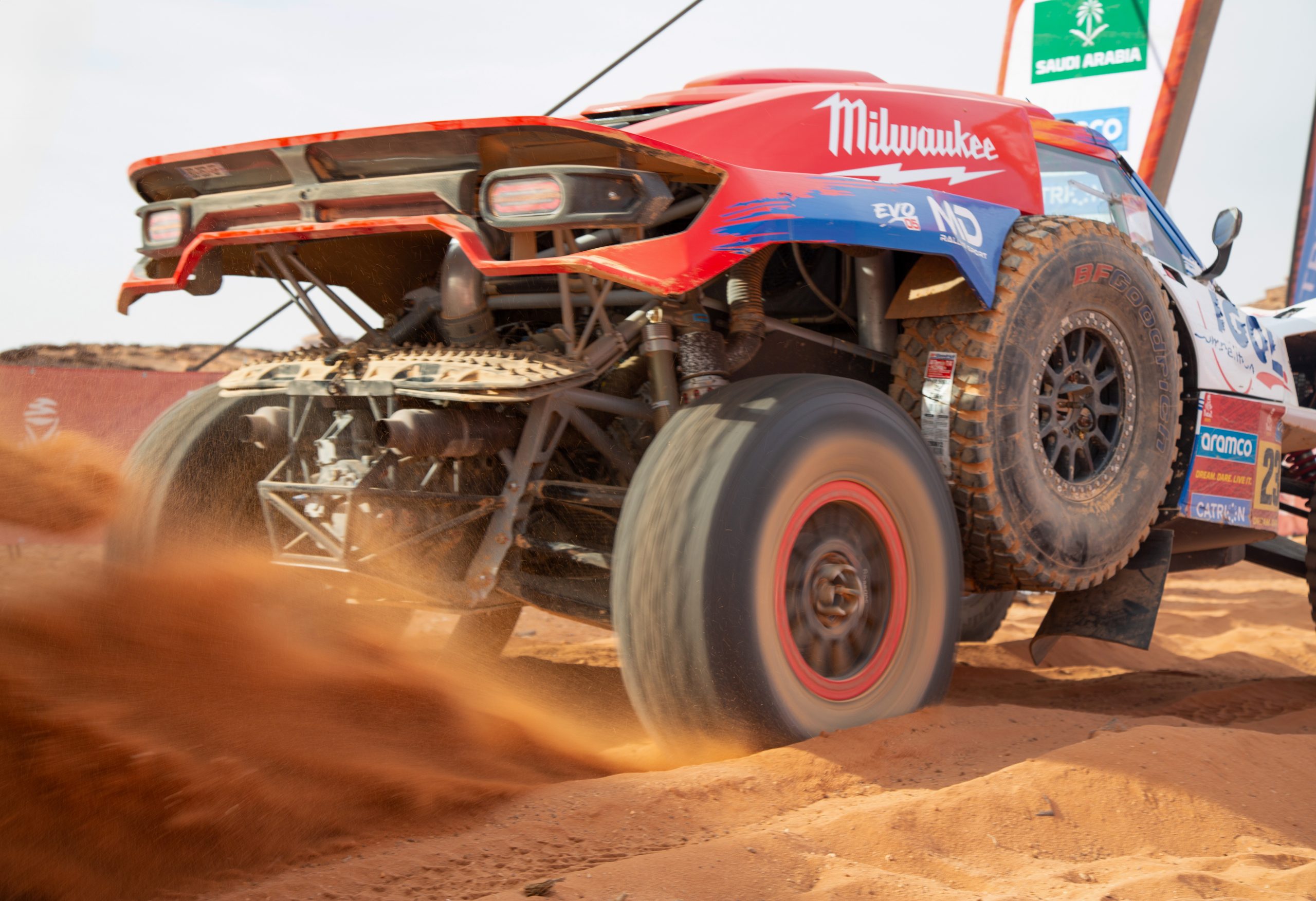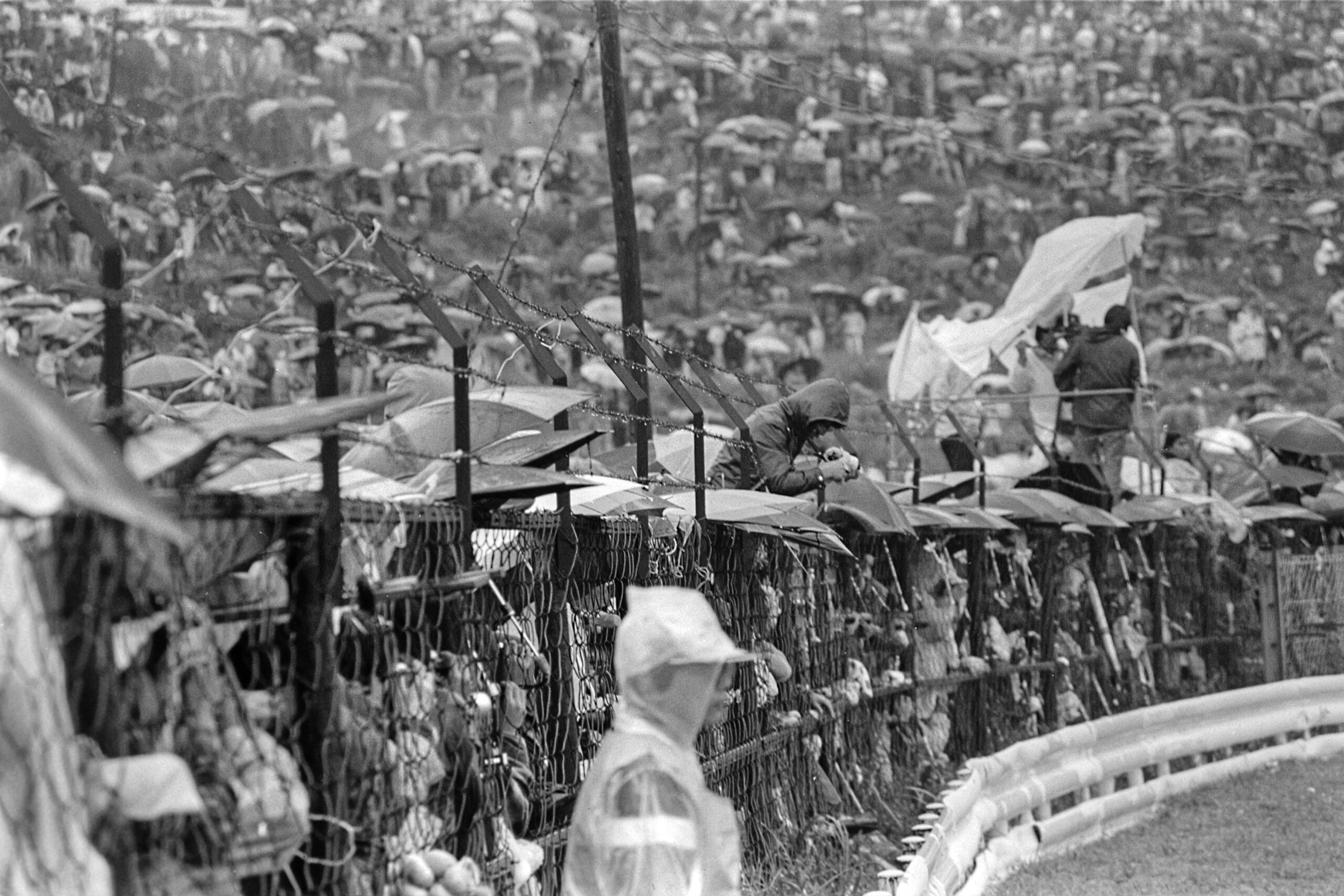In the theatre, watching the rain fall in sheets over James Hunt’s McLaren and Niki Lauda’s Ferrari F1 cars, you could feel the tension building. At the conclusion of 2013’s Rush, the 1976 Japanese Grand Prix provided the ideal setting for the final chapter of one of the greatest rivalries seen in motorsport, this last story only lightly fictionalised. The real event, the first Formula 1 race held in the shadow of Mount Fuji, marked the western world’s first proper look at racing in Japan.

But long before Hunt vs. Lauda, some of the most thrilling, vicious, tactical racing in the world had already taken place on these grounds: No-holds-barred battles between Toyota and Nissan, as they fought to take the lead both at the track and as leader in the ascending Japanese automotive industry; knife-fights between big-block Chevy V8 monsters and 2-litre Porsche bantamweights; newly minted hometown racing heroes and household names like Elford, Hailwood, Moss. And even a secret agent, lurking in the shadows.

Between 1963 and 1969, the Japanese Grand Prix was held six times, each instance turning up the volume on the power and the danger. Generally not well known outside of Japan, these races created legends that are now locked away in Toyota and Nissan warehouses, and one hidden in a Southern California basement. They blazed the way for Japanese sports car racing of the kind that would see Mazda and Toyota finally take their wins at Le Mans. And they would end with some of the most tantalising what-might-have been stories to have ever come out of the Land of the Rising Sun. Here are the tales of a forgotten golden age – Japanese Grand Prix racing through the 1960s.
Tamagawa: The Twilight Before the Dawn
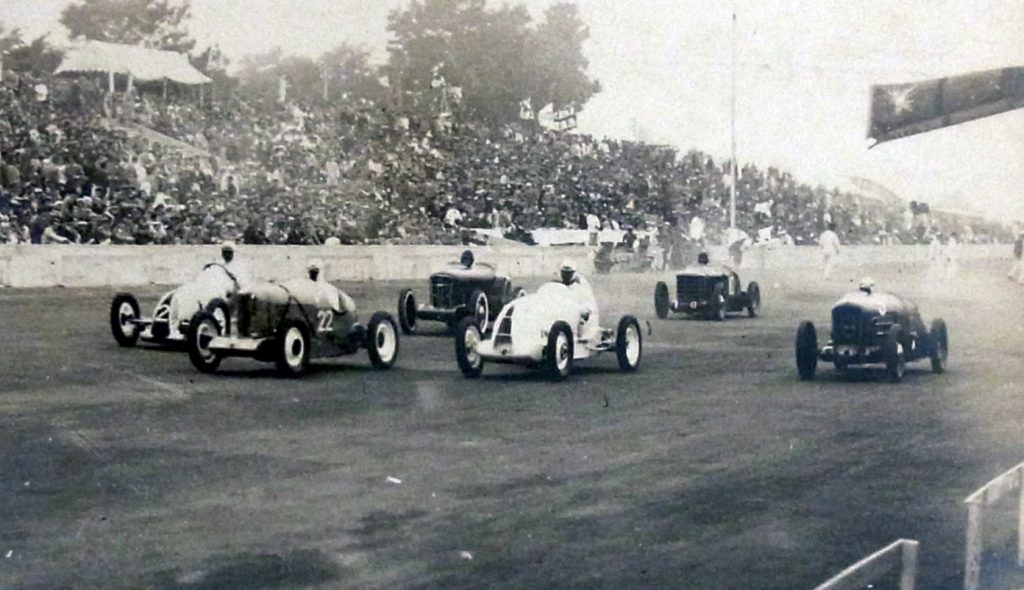
Most histories of motorsport in Japan place the first races as held at the then-newly constructed Suzuka Circuit in the early 1960s. Suzuka, personally commissioned by Soichiro Honda, has a much earlier ancestor, one that would be all-too-familar to Dr. Honda himself.
Properly, we must begin our story in 1936, at the Tamagawa Speedway. A three-quarter-mile dirt oval, it was Japan’s first purpose-built racing circuit, of a type that would have been familiar to any racing fan across the Pacific. This was no accident, as founder Gunji Fujimoto had lived his early life in Seattle, a member of the early Japanese community in the Pacific Northwest, and he wanted to bring back American-style dirt-track oval racing to his native land.
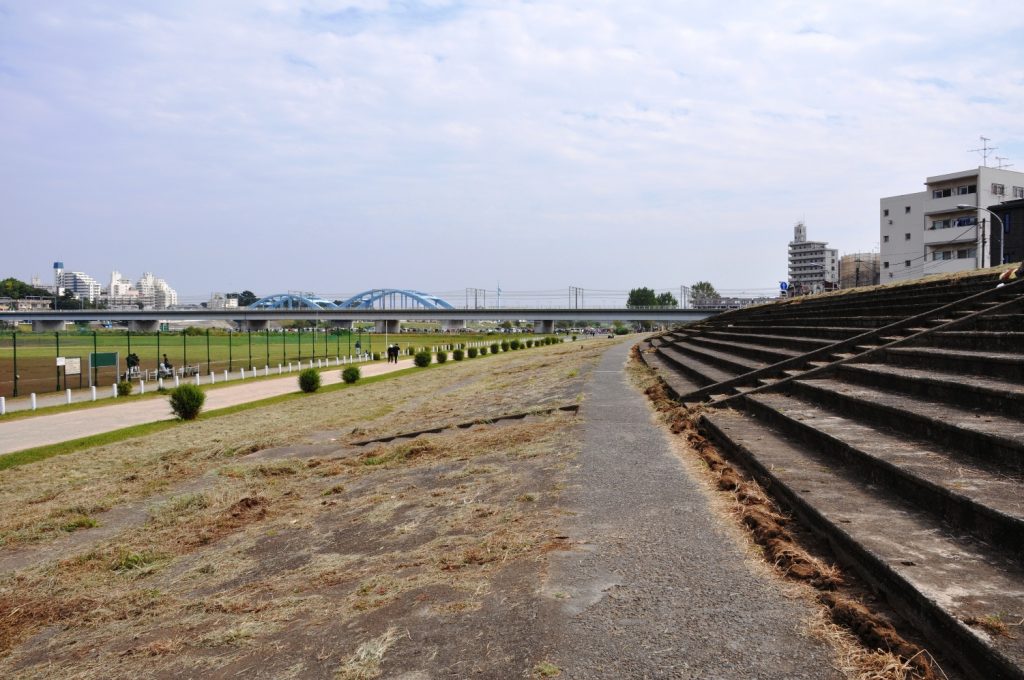
The racers were Japanese, their machines mostly foreign. Bugattis and Bentleys slid through the dirt, pursued by Curtiss Specials and the like. At one race, the driver and riding mechanic of a turbocharged Ford dubbed Hamamatsu, brothers Sochiro and Benjiro Honda, found themselves inconveniently airborne. Injuries from the crash would end Dr. Honda’s personal racing career, though not his obsession with motorsport.
At the same time, one of Nissan’s early founders saw his cars losing a race classed for domestic cars and declared that they would be victorious by the end of the year. He was right, though these early racing days would fade quickly, WWII materiel rationing and postwar rebuilding making for a long pause.
Suzuka 1963–64: Foreshadowing
As mentioned, Suzuka Circuit was and remains Honda’s home racing circuit. Completed in 1962, the figure-eight racetrack was a Herculean effort from such a small company, with tarmac samples from European circuits flown back to Japan and analysed for months; no Japanese paving company had experience creating a purpose-built racing circuit.
The first races were motorcycle events, using a modified version of the Isle of Man TT rulebook. Honda had met with success at the TT already, and the original idea for Suzuka was as a test facility for the company’s bikes.
The following year, 1963, the circuit hosted the inaugural Japanese Grand Prix, and the state of the Japanese automobile industry can be seen in its absence from the main event. Sports car entries were almost all European teams, and the event was won by Englishman Peter Warr in a Lotus. Warr would later serve as a manager for the Lotus racing team and Walter Wolf Racing.
However, in the smaller class, where British sports cars like Triumphs and MGs were expected to dominate, an unlikely privateer came to the fore. Driving his own Fairlady 1500, with minimal sponsorship and next to no factory support, local enthusiast Genichiro Tawara beat the rest of the field by an impressive six seconds.
The next year was even more important for Japanese pride. In 1964, entered as underdogs against the Europeans, including a mid-engined Porsche 904 Carrera GTS, a pair of Prince Skylines established that nameplate’s first success. It wasn’t an outright win, but when the long-nosed Skyline GTB driven by racer Tetsu Ikuzawa (remember this name, as you haven’t heard the last of him) managed to pass the Porsche briefly, the crowd rose to their feet in approval. Japan had caught racing fever.
Fuji 1966–67: The Shadow and the Gambler
Having only just begun, Japan’s premier racing series went on hiatus for 1965. Various reasons for the organisers taking a gap year are reported, but the answer is probably money, as Suzuka’s management is said to have hiked its fee significantly. There was, however, another option in the works.
Like Tamagawa, Fuji Speedway was originally going to be an oval circuit, designed to hold NASCAR-style superspeedway racing: Daytona in the East. If the idea of a quintessentially American sport gaining popularity in Japan seems unlikely, just look at how things went with baseball. But the ground chosen was on too great a slope to be suitable, and instead plans changed to a road-course layout, with the input of none other than Stirling Moss.
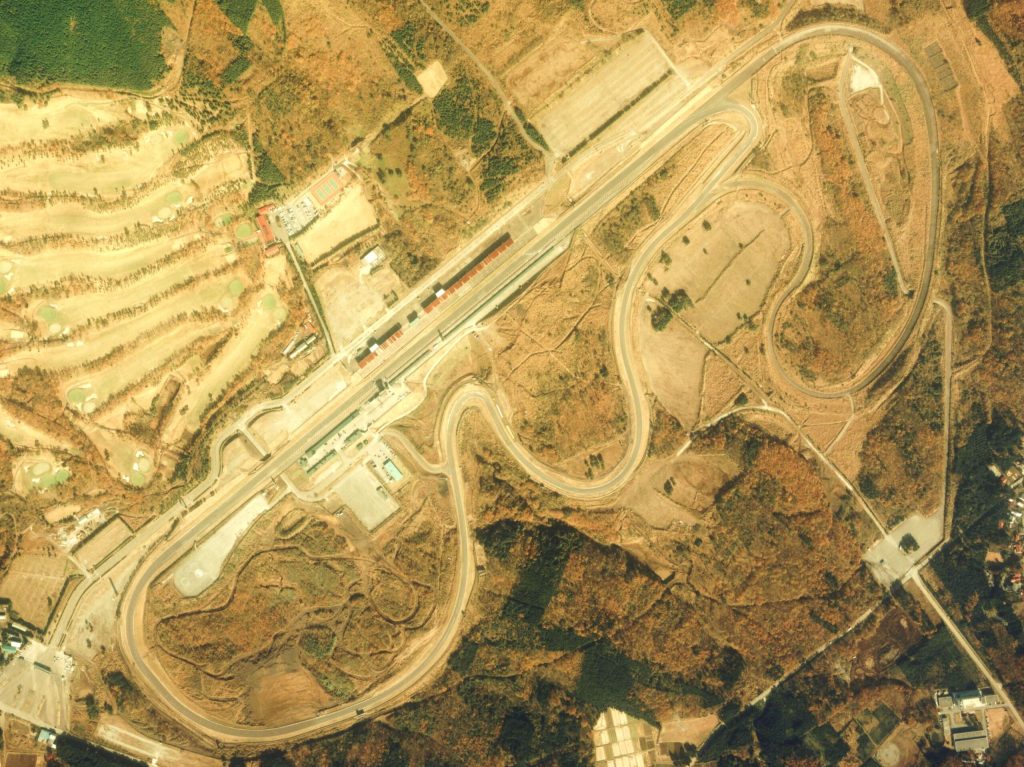
Looming just over the shoulder of Moss was a mysterious and enigmatic figure by the name of Don Nichols. Racing fans might clock that name, as Nichols was the founder of the long-running Shadow sports car and F1 teams, its mascot a stylised spy. The choice was no coincidence, as before his racing career, Nichols was a counterintelligence agent living in Japan. James Bond fighting SPECTRE in Japan in 1967’s You Only Live Twice was fiction, but Nichols scrapping it out with Soviet agents in Cold War–era Tokyo was real, although he’d never say exactly what he’d done.
The full life of Don Nichols is far too varied (yet interesting) to include here, so if your interest is piqued, try author Pete Lyons’ excellent look at the story of Shadow. Just know that Nichols was at the heart of many a move during this era of Japanese motorsport, working behind the scenes.
Also never far from the action was Tetsu Ikuzawa. In 1966, he was again racing for Prince, this time in one of four mid-engined R380s, one of the first proper Japanese prototype racing machines, and built to FIA Group 6 regulations. Powered by a twin-cam 2-litre inline-six engine, it was a huge technical leap forward over the earlier Skylines, and theoretically a worthy foe to the Porsches.
The field that year could not have been more varied. Toyota, just about to launch the road-going 2000GT, entered a race-prepped version called the 311S. With a lightened chassis and inline-six engine tuned to somewhere above 200bhp, its traditional GT racer layout might have raised the eyebrows of the Jaguar E-Type racing teams that had also entered.
Perhaps most shocking to see in the pits was a Shelby Daytona Coupe, the brainchild of Peter Brock. The real threat, however, were the mid-engined Porsches, which very nearly won the race, despite a concerted blocking effort from the Prince team. Ikuzawa’s car was felled with a mechanical failure, but the R380 driven by teammate Yoshikazu Sunako took the win. It was the last GP win for Prince, who would be under Nissan’s ownership going forward.
The next year, Ikuzawa was back, this time with a Porsche. He’d spent part of the time between the Grand Prix living in the U.K. and racing for a team run by Stirling Moss. Finding no seat was available from his old Prince teammates, now that Nissan was in charge, he put together his own sponsorship drive and managed to round up enough support to lease a Porsche 906, chassis 145. This car, with its distinctive yellow-and-white livery, is still sufficiently famous in Japan that Porsche created a one-off modern tribute to it two years ago, based on a GT4.
Unlike the factory teams, who were racing for bragging rights, Ikuzawa was fighting for his future. Win the purse, and he’d have sufficient backing to continue his career in the U.K., leading perhaps to an eventual seat in F1. Lose, and that door might close forever.
It’s worth pausing here to talk about the monster of Fuji, the insanely dangerous Daiichi corner. A relic of the original superspeedway plan, this 30-degree banked turn required drivers to approach over a blind crest at full commitment, then drop into the banking at top speed and ride it out.
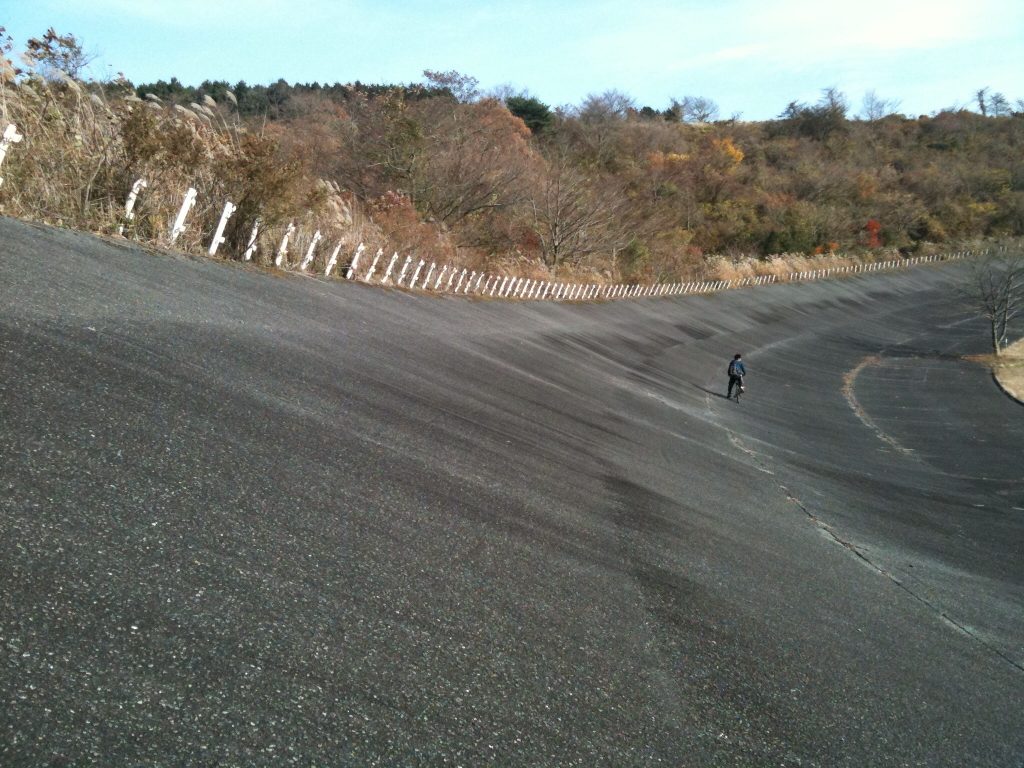
After putting his 906 on pole, and a fantastic early battle with the upgraded Nissan prototypes, Ikuzawa found himself in a dogfight with one of the other Porsche 906s. This one was driven by Tadashi Sakai, the pilot of last year’s Shelby Daytona, and the pair exchanged first and second positions through the middle of the race, blocking and jockeying for position. With 14 laps to go, the Porsches dropped into Daiichi at over 150 mph, and right at the exit of the corner, Sakai’s right rear tyre exploded. His car was flung off the track, right through the guardrail, yet incredibly he survived with only superficial injuries.
Brushing off an instruction to pit, Ikuzawa managed to hold off the hard-charging Nissan team to take victory, also setting the fastest lap during the race. It was enough to send him back to the British Formula 3 championship where, just a few months later, he would win outright at Brands Hatch.
[A footnote for those interested in the more obscure elements of Japanese classic machines. One long-lost race car that entered but did not start at the 1967 Japanese Grand Prix was the gorgeous Hino Samurai. Hino was one of the smaller Japanese companies that was snapped up during the consolidation of Japan’s automotive industry, in this case coming under the control of Toyota. Today it mostly builds trucks, but in the past it made lovely little French-inspired cars and raced them in the U.S. with Peter Brock’s BRE. The Samurai was the ultimate expression of the BRE-Hino partnership, a mid-engined prototype racer with an adjustable rear wing. Fuji Speedway scrutineering failed it for being too low, though Brock himself contests that this was a political move, as Toyota didn’t want Hino’s car-building prowess to receive any reflected glory from racing success (Hino built the Hilux, and Toyota wanted its trucks). At last report, the partially restored Hino Samurai languishes in a Southern California basement garage, yearning for its long-awaited time in the sun.]
Fuji 1968–69: “Monster Bird” and the Last of the Kaiju
As noted previously, Japan’s racing history was as much inspired by North American racing as it was by that found on European circuits. As the end of the 1960s loomed, there was thus inspiration to be taken from the FIA’s new Group 7 rule book: the Can-Am machines.
Can-Am cars had already raced at Fuji Speedway – two Lola T70s, one with Don Nichols at the wheel – but those cars had been greatly restricted to level the playing field. Now all bets were off, and Nissan kicked off development of a hugely winged roadster, likely inspired by the Chaparral 2F, to be powered by a V12. This motor, the GRX-1, was intended to be the most powerful engine Nissan had ever produced.
Meanwhile, Toyota was back after taking a hiatus for the 1967 race, and it meant business. Its 415S, better known simply as the Toyota 7 (after its Group classification) was conventional and lightweight, powered by a reliable 3-litre twin-cam V8.
At the same time, Can-Am regulations had opened up the contest to privateer racers with a number of very competitive entries. Shintaro Taki, a multiple-time Japanese Grand Prix entrant who raced one of the Porsches in 1967, would field several V8-powered Lolas, as well as two mid-engined Porsches. All told, some 30 entrants lined up for the start at Fuji in 1968.
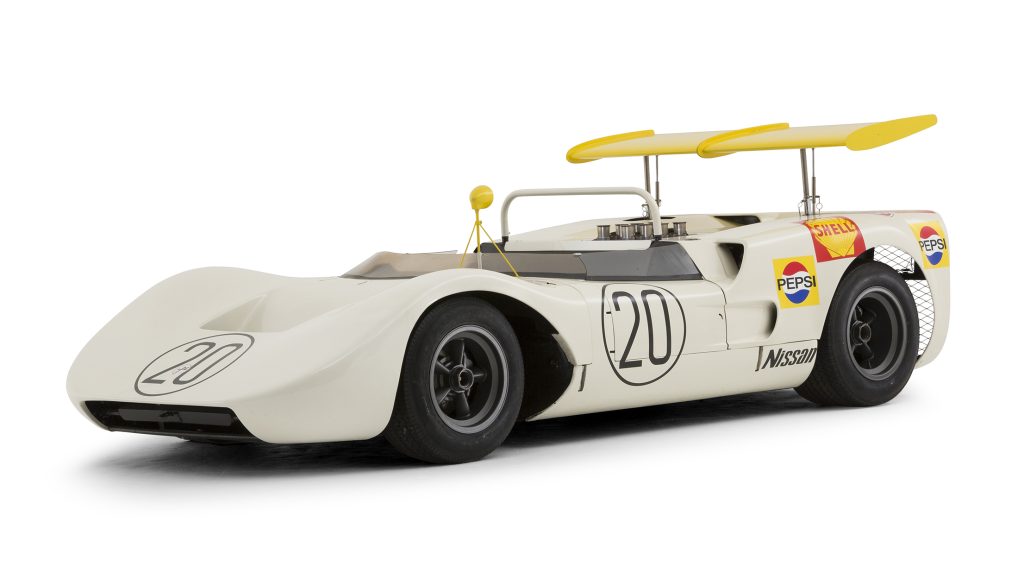
Nissan’s entry, the R381 nicknamed “Monster Bird” for its huge spoiler, hadn’t got its V12. The GRX-1 wasn’t fully developed in time for the race, but Nissan team leader Shinichiro Sakurai – the engineer often credited as the “Father of the Skyline” – had an ace up his sleeve. Using Nichols as a connection, he’d flown to California and met with legendary tuner Dean Moon, of Mooneyes fame. Moon would provide Nissan with his 5.5-litre small-block Chevrolet V8s, tuned to a little over 450bhp. Anyone who’s ever stuffed an LS into a 240Z should smile to know that even Nissan itself pulled pretty much the same move when push came to shove.
The race was a war of attrition, with many of the larger-engined cars falling off due to mechanical faults or crashes. Tetsu Ikuzawa, driving a theoretically outmatched Porsche 910, managed to claw his way up to a very respectable second-place finish. But victory would go to the Monster Bird and its Chevy V8, the win made all the sweeter as it marked driver Moto Kitano’s triumphant comeback. Kitano had crashed while racing motorcycles for Honda at the Isle of Man TT, his injuries forcing him to turn to four-wheeled racing. At the 1968 Japanese Grand Prix, he stood at the very top of the podium.
For 1969, the Japanese Auto Federation moved the Grand Prix to later in the year, allowing for a Formula Grand Prix to take its place in early summer. This had the result of allowing international drivers to compete, as the overseas sports car racing season would have been completed. The race was also now longer, at just under 450 miles, so two-driver teams were allowed.
Nissan and Toyota were tooled up for battle. Toyota had ditched the 3-litre V8 for a 530bhp 5-litre V8. With a reworked chassis, the new Toyota 7 already had a couple of convincing wins under its belt when it showed up at Fuji, spoiling for a fight.
Meanwhile, Nissan had got its V12 sorted out. Now displacing six litres, the GRX-3 made about 600bhp, giving the R382 a power-to-weight ratio better than the Le Mans–winning McLaren F1 GTR would achieve some 26 years later.
Porsche’s 12-cylinder power was also in the fray, in the form of the flat-12 mounted amidships in its new 917. And there were even a couple of McLaren M12s joining the Lolas and other V8-powered specials.
As it turned out, nobody stood a chance against the Nissans. Kitano put his car on pole, and not even Daytona- and Monte Carlo–winning driver “Quick” Vic Elford could get the Toyota 7 to do better. In the race itself, the Toyotas and Porsches acquitted themselves well, but in the end it was Nissan with the top two podium results, Toyota settling for third and fourth.
Sunset at Fuji
In June 1970, just four months before the seventh running of the Japanese Grand Prix that October, Nissan pulled the plug. Both it and Toyota had already developed two of the most powerful racing machines of the era, squaring up for the equivalent of a Godzilla vs. Mothra showdown. The Toyota 7 Turbo made over 700bhp with its twin-turbocharged V8. Nissan’s R383 was set to respond with a twin-turbo V12 good for an astonishing 900bhp.
Instead, both companies would withdraw. Without them, the Japan Automobile Federation (JAF) had little alternative but to cancel that fall’s race. The era of hugely powerful sports car racing in Japan was over.
Years later, the Japanese Grand Prix would return as a Formula 1 race, first at Fuji, and later at Suzuka. Japan would finally get its first F1 racing driver, and still has one today in the person of Yuki Tsunoda. The descendants of those Nissan and Toyota prototype sports cars competed in endurance racing all over the globe, Toyota today with five hard-fought Le Mans victories. And to this day, Tetsu Ikuzawa remains the only factory Porsche driver to have come from Japan.
